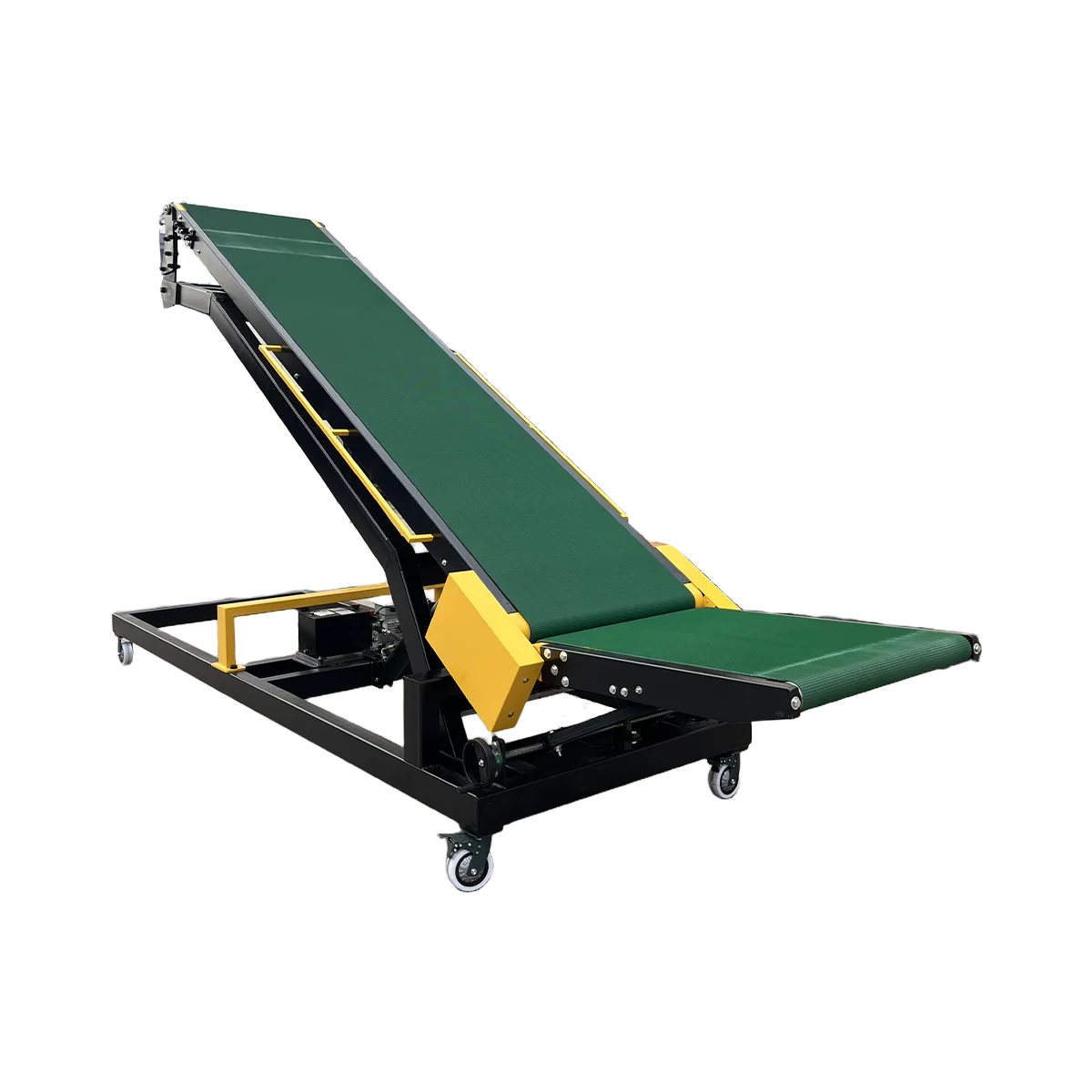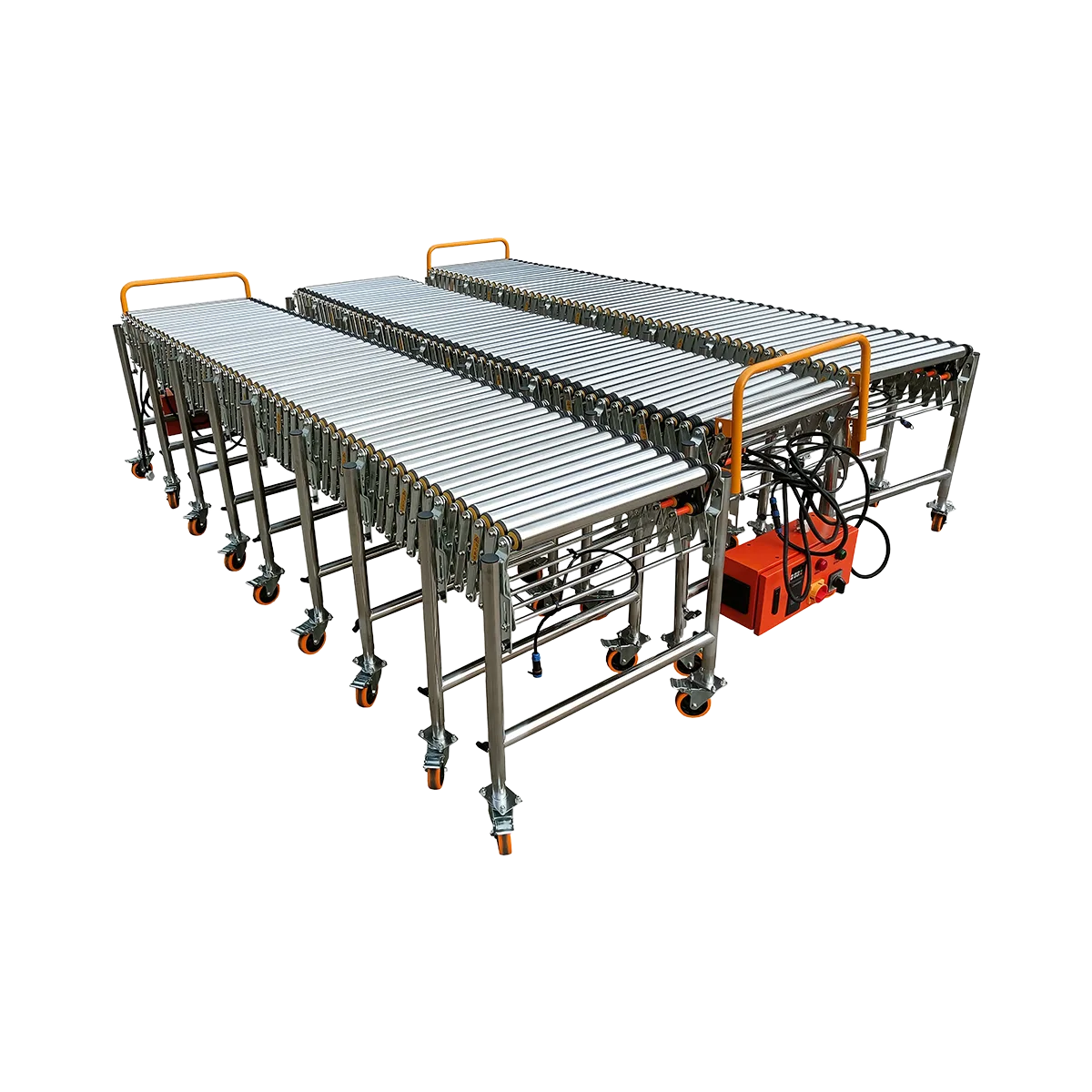How to Unload a 40ft Container in Under 30 Minutes
Transform your 40ft container unloading process from hours to minutes with telescopic conveyor systems. Discover proven methods for fast container unloading efficiency.
Related Products
- TeleScopic Conveyor – 4 SectionsCollapsed LengthExtended LengthLoad Capacity
60 kg/m
Applicable GoodsFlat-bottomed Goods
Bagged Goods
- Hydraulic Conveyor – Large – 7900 mm LengthCollapsed LengthExtended LengthLoad Capacity
80 kg/m
Applicable GoodsFlat-bottomed Goods
Bagged Goods
- Powered Roller Conveyor – Multi-wedge Belt Driven – 2000 mm/SectionCollapsed Length
700 mm
Extended Length2000 mm
Load Capacity100 kg/m
Applicable GoodsFlat-bottomed Goods
Every logistics manager knows the mounting pressure when a 40ft container arrives at the facility. Traditional 40ft container unloading methods can easily consume 2-3 hours of valuable time and require 4-5 laborers working intensively. This time-consuming process creates operational bottlenecks, increases labor costs, and delays downstream workflows throughout your warehouse. In today’s fast-paced logistics environment, where quick turnaround is critical to operational success, inefficient unloading procedures directly impact your bottom line.
The challenge becomes even more significant when multiple containers arrive simultaneously or when you’re working with time-sensitive shipments. Optimizing the unloading process isn’t merely about working faster—it requires fundamentally rethinking the equipment and workflows that bridge the gap between container and warehouse.
This article reveals how implementing a specialized telescopic conveyor system can dramatically transform your container unloading process, reducing what traditionally takes hours into a streamlined operation completed in under 30 minutes.
The Challenge: Why Unloading a 40ft Container is a Major Bottleneck
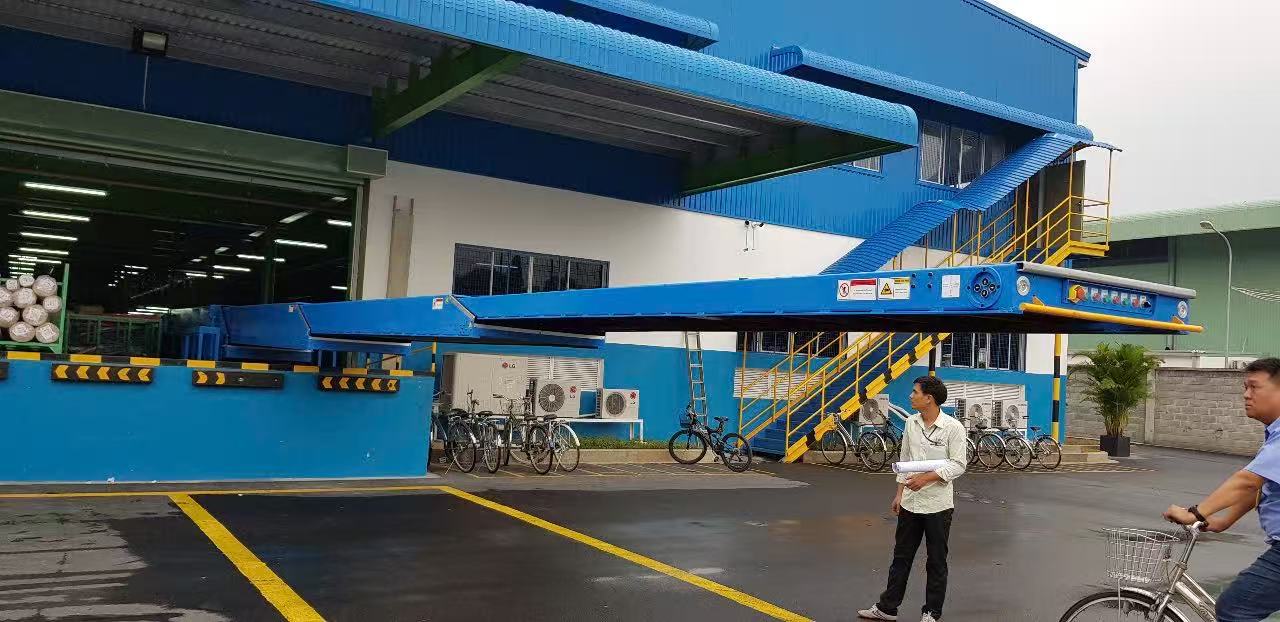

The standard 40ft shipping container presents several inherent challenges that make efficient unloading particularly difficult:
The Deep Reach Problem
The 40ft (12.19m) internal length of the container creates a significant distance challenge. As workers unload, they must travel progressively deeper into the container to retrieve items, then walk them back to the entrance. This repeated long-distance movement becomes increasingly time-consuming and physically demanding.
Consider the math: A worker retrieving boxes from the back of the container might walk 24 meters (in and out) for each trip. Multiply this by hundreds of items, and workers may collectively walk several kilometers during a single container unloading process.
The Fatigue Factor
The physical toll of manual unloading cannot be overstated:
- Repeated bending and lifting causes rapid worker fatigue
- The container’s confined space creates uncomfortable working conditions
- Temperature extremes inside metal containers exacerbate physical stress
- Productivity naturally decreases as fatigue increases
- Injury risks rise throughout the unloading process
The Sequential Limitations
Traditional unloading processes are fundamentally sequential and single-file by nature:
- Only 1-2 workers can typically work inside the container simultaneously
- Items must be passed or carried out one by one
- The process slows significantly as workers reach deeper sections
- Each item requires multiple touchpoints before reaching its destination
- Work progress becomes increasingly inefficient as the container empties
The Visibility and Coordination Challenges
Poor lighting inside containers and communication difficulties between workers inside and outside create additional inefficiencies:
- Limited visibility increases handling time and error rates
- Communication barriers between inside and outside teams create coordination problems
- Maintaining optimal workflow pacing becomes difficult
- Constant adjustments to unloading strategy are required
These combined factors make fast container unloading exceptionally difficult using traditional methods, creating a significant operational bottleneck that impacts your entire supply chain.
The Solution: A Naili 4-Stage Telescopic Conveyor
The most effective solution to these container unloading challenges is a specialized Naili 4-Stage Telescopic Conveyor system. This purpose-built equipment dramatically transforms the unloading process by creating a continuous, extendable conveyor path directly into the container.


How it reaches the very end of the container, eliminating manual carrying
The defining feature of Naili’s 4-Stage Telescopic Conveyor is its remarkable extension capability, specifically designed to address the full depth of a 40ft container:
Extended Reach Capacity:
- Fixed section length options from 5-8 meters
- Maximum extension capability of 9-17 meters
- The NLS-4-7/14 model offers 7m fixed length with 14m extension (21m total)
- The NLS-4-8/17 model provides 8m fixed length with 17m extension (25m total)
This extension capability ensures the conveyor can reach the very back of a 40ft container (12.19m internal length), completely eliminating the need for workers to carry items from deep inside the container to the entrance.
Precision Engineering Features:
The 4-section telescopic design incorporates:
- Nested boom sections that extend and retract via powered mechanisms
- A continuous belt surface running through all sections
- Precision-manufactured boom sections with varying heights (750mm, 455mm, 309mm, and 165mm)
- High-quality steel construction (6mm BS700/T700 steel for main sections)
- Seamless steel drive rollers (180mm diameter with 10mm rubber coating)
Operational Advantages:
This specialized design creates several critical advantages:
- The conveyor belt extends directly to the container’s furthest point
- Workers can place items directly onto the moving belt
- Products move automatically from container interior to the warehouse
- The belt provides consistent 10-40 m/min speed regardless of container depth
- Built-in LED lighting improves visibility throughout the container
By creating a continuous mechanical path from the deepest part of the container to your warehouse, the telescopic conveyor eliminates the most time-consuming element of traditional unloading: the repetitive walking and carrying.
Step-by-Step Unloading Process with a Telescopic Conveyor
Implementing an efficient container unloading process with a telescopic conveyor requires a systematic approach. Here’s the optimized workflow that can help you achieve 30-minute container unloading:
Positioning the conveyor
- Dock preparation:
- Ensure the loading dock is clear of obstacles
- Verify the dock height matches container floor height (typically 1.2-1.4m)
- Position the telescopic conveyor perpendicular to the container opening
- If using casters, lock them firmly once in position
- Container alignment:
- Back the container directly against the loading dock
- Ensure proper sealing between container and dock to eliminate gaps
- Open container doors fully and secure them
- Verify safe access between dock and container floor
- Initial conveyor positioning:
- Align the telescopic conveyor with the center of the container opening
- Position receiving staff and equipment at the fixed end of the conveyor
- Clear the extension path to prevent obstructions
- Ensure control panel accessibility for the operator
Extending the boom as the container empties
- Initial extension:
- Begin with the conveyor retracted to its fixed section length
- Activate the extension motor to send the first boom section into the container
- Extend approximately 2-3 meters initially, keeping the belt running
- Start unloading items nearest to the entrance onto the conveyor
- Progressive extension strategy:
- As the nearest items are cleared, gradually extend the conveyor deeper
- Maintain a consistent unloading pace rather than extending all at once
- Coordinate extension with unloading progress to maintain workflow
- Use the variable speed control (10-40 m/min) to match worker pace
- Full extension technique:
- Continue extending until reaching the deepest remaining items
- The 4-section telescopic design enables reaching the very back of a 40ft container
- Adjust conveyor height using the hydraulic lift option if necessary for ergonomics
- Use built-in LED lights to improve visibility in the container’s depths


Using the operator platform and front controls for maximum efficiency
- Optimal operator positioning:
- Position one operator at the front control panel on the extended section
- If equipped with the operator platform option, station a worker on this elevated position
- The platform provides better visibility and ergonomic reach for top-stacked items
- Front controls allow precise adjustments to extension and belt speed from inside the container
- Coordinated workflow management:
- The front operator controls the pace and directs the unloading sequence
- Use the front control panel to make real-time adjustments to belt speed
- Maintain continuous communication between front and receiving operators
- Leverage the emergency stop function at both ends if needed for safety
- Final clearing technique:
- Use the conveyor’s ability to adjust incline angle for accessing final items
- Clear the container systematically from back to front and top to bottom
- Utilize the front LED lighting to ensure no items are missed
- Begin retracting the conveyor progressively as sections are cleared
With proper implementation of this workflow, a typical 40ft container filled with standard cartons can be unloaded in 25-35 minutes with just 2-3 workers—a dramatic improvement over traditional methods requiring 2-3 hours and 4-5 workers.
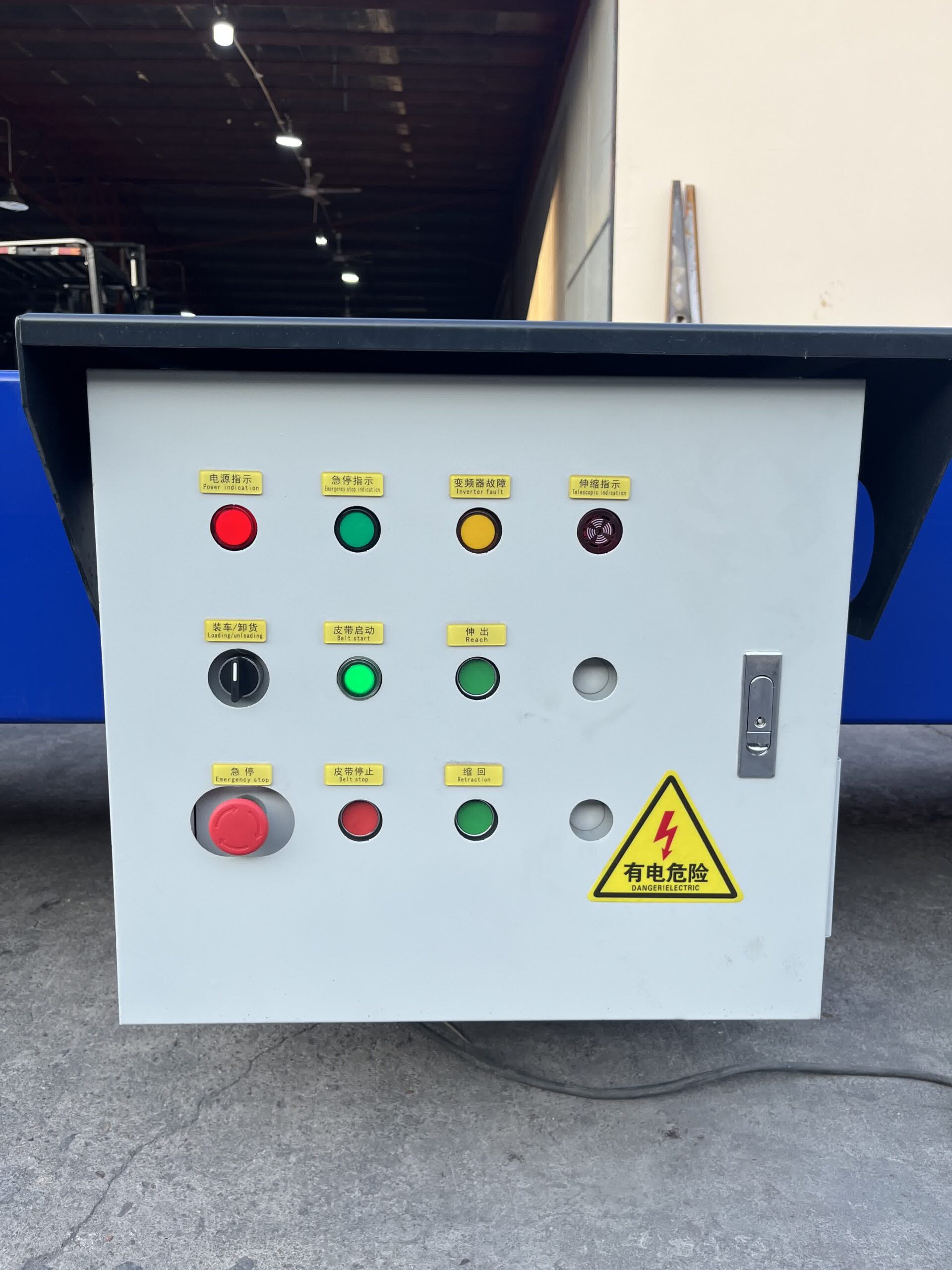

Comparing the Numbers: Manual Unloading vs. Naili Telescopic Conveyor
The contrast between traditional manual unloading and the telescopic conveyor method reveals dramatic efficiency differences across multiple metrics:
Time Saved: From hours to minutes
Total Unloading Duration:
| Unloading Method | Small Parcels (≤5kg) | Medium Boxes (5-15kg) | Large Cartons (15-30kg) | Heavy Items (40-50kg) |
| Manual Process | 120-180 minutes | 150-210 minutes | 180-240 minutes | 210-270 minutes |
| Telescopic Conveyor | 25-35 minutes | 30-45 minutes | 40-50 minutes | 45-60 minutes |
| Time Savings | 78-81% | 79-80% | 78-79% | 78-79% |
Throughput Rates:
The telescopic conveyor enables dramatically higher processing speeds:
- Small parcels: 3,500-5,000 pieces per hour
- Medium boxes: 2,500-3,500 pieces per hour
- Large cartons: 2,000-2,500 pieces per hour
- Heavy bagged goods: 1,500-2,000 pieces per hour
These rates represent 3-4 times the throughput possible with manual unloading methods.
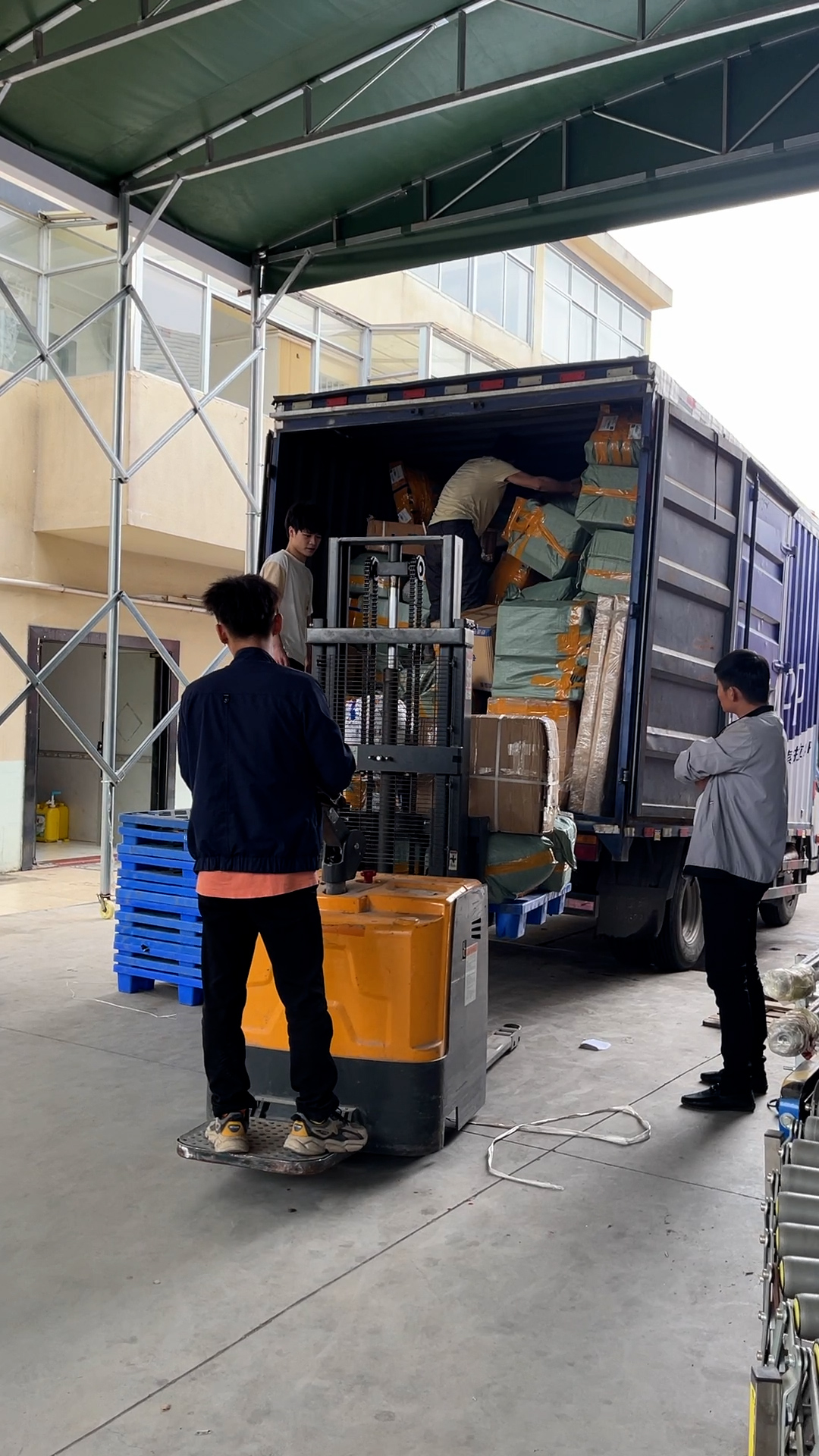

Labor Saved: Reducing a 4-person team to 2
Labor Requirements Comparison:
| Unloading Method | Workers Required | Worker-Hours Per Container | Annual Labor Hours (250 containers) |
| Manual Process | 4-5 workers | 8-15 worker-hours | 2,000-3,750 worker-hours |
| Telescopic Conveyor | 2-3 workers | 1-2.5 worker-hours | 250-625 worker-hours |
| Resource Savings | 40-60% fewer workers | 75-90% fewer worker-hours | 1,750-3,125 hours saved annually |
Physical Toll Reduction:
The telescopic conveyor significantly reduces:
- Walking distance per container: From 5+ kilometers to less than 1 kilometer
- Lifting actions per worker: From 500+ to fewer than 150
- Ergonomic injury risks: Substantial reduction in bending, reaching, and carrying
- Worker fatigue: Maintaining productivity throughout the shift
Operational Advantages:
Beyond direct time and labor savings, the telescopic conveyor provides:
- More predictable unloading schedules
- Reduced dock occupancy time
- Faster inventory availability
- Lower product damage rates
- Improved worker satisfaction and retention
The financial impact is substantial: For operations handling 250+ containers annually, the investment in a Naili 4-Stage Telescopic Conveyor typically achieves complete return-on-investment within 6-12 months through labor savings and operational improvements.
Stop Manually Unloading, Start Optimizing
The 40ft shipping container conveyor revolution is fundamentally changing how logistics operations approach container unloading. With Naili’s 4-Stage Telescopic Conveyor system, what was once an unavoidable multi-hour bottleneck can be transformed into an efficient 30-minute process.
This transformation delivers far-reaching benefits beyond just the immediate time savings:
- Labor optimization: Redirect staff to higher-value activities instead of manual carrying
- Scheduling precision: Know exactly when containers will be emptied and available
- Worker health: Reduce physical strain, fatigue, and potential injuries
- Throughput capacity: Process more containers per day with the same dock infrastructure
- Downstream efficiency: Provide steady, predictable flow of goods to sorting and putaway operations
The most successful implementations couple the right equipment with revised workflows and proper training. By positioning the telescopic conveyor as the centerpiece of your container unloading strategy, you create a continuous flow from container to warehouse that eliminates the traditional stop-and-go manual process.
For operations handling multiple containers daily, the competitive advantage gained through this efficient logistics transformation can be substantial. While the initial investment in a quality telescopic conveyor system represents a significant capital expenditure, the rapid return on investment through labor savings and operational improvements makes this a compelling business case for most medium to large logistics operations.
The question is no longer whether you can afford to implement this solution, but whether you can afford not to, as competitors embrace these efficiency-driving technologies.


Frequently Asked Questions
Is a telescopic conveyor suitable for all types of container cargo?
Telescopic conveyors work best with boxed goods, parcels, and standard cartons that have flat, stable bottoms. While they excel with most conventional logistics packages, extremely heavy items (over 60kg/m²), very small loose items, or irregularly shaped goods may require supplemental handling methods. Naili’s systems are rated for up to 60kg/m² capacity, suitable for most standard logistics applications.
What infrastructure is needed to implement a telescopic conveyor system?
The primary requirement is a loading dock of appropriate height (typically 1.2-1.4m) with sufficient space for the conveyor’s fixed section (5-8m). You’ll need three-phase power supply (typically 380V) for the conveyor and telescoping motors (2.2kW and 0.75kW respectively). No permanent installation or floor modifications are typically required, though larger models should be used on surfaces rated for their weight (2.1-3.0 tons).
Can the telescopic conveyor be used for loading containers as well?
Yes, Naili’s telescopic conveyors are bidirectional and equally effective for loading operations. The workflow is essentially reversed, with the conveyor extended fully at the start and gradually retracted as the container fills. Many facilities use the same equipment for both loading and unloading operations, maximizing the return on investment.
How much training is required for staff to operate a telescopic conveyor system?
Minimal training is required. The intuitive control systems can typically be mastered in a single training session of 1-2 hours. Most operations find that workers become proficient after unloading 2-3 containers under supervision. The control panels are designed for straightforward operation, with simple forward/reverse, speed control, and extension/retraction functions.
What maintenance is required for a telescopic conveyor system?
Regular maintenance is relatively simple: daily visual inspections, monthly light maintenance (cleaning, fastener checks), and quarterly comprehensive maintenance (lubrication, electrical system checks). Key components like the conveyor belt typically last 2-3 years depending on usage intensity. Naili’s telescopic conveyors are engineered for durability, with most systems providing 8-10 years of service when properly maintained.
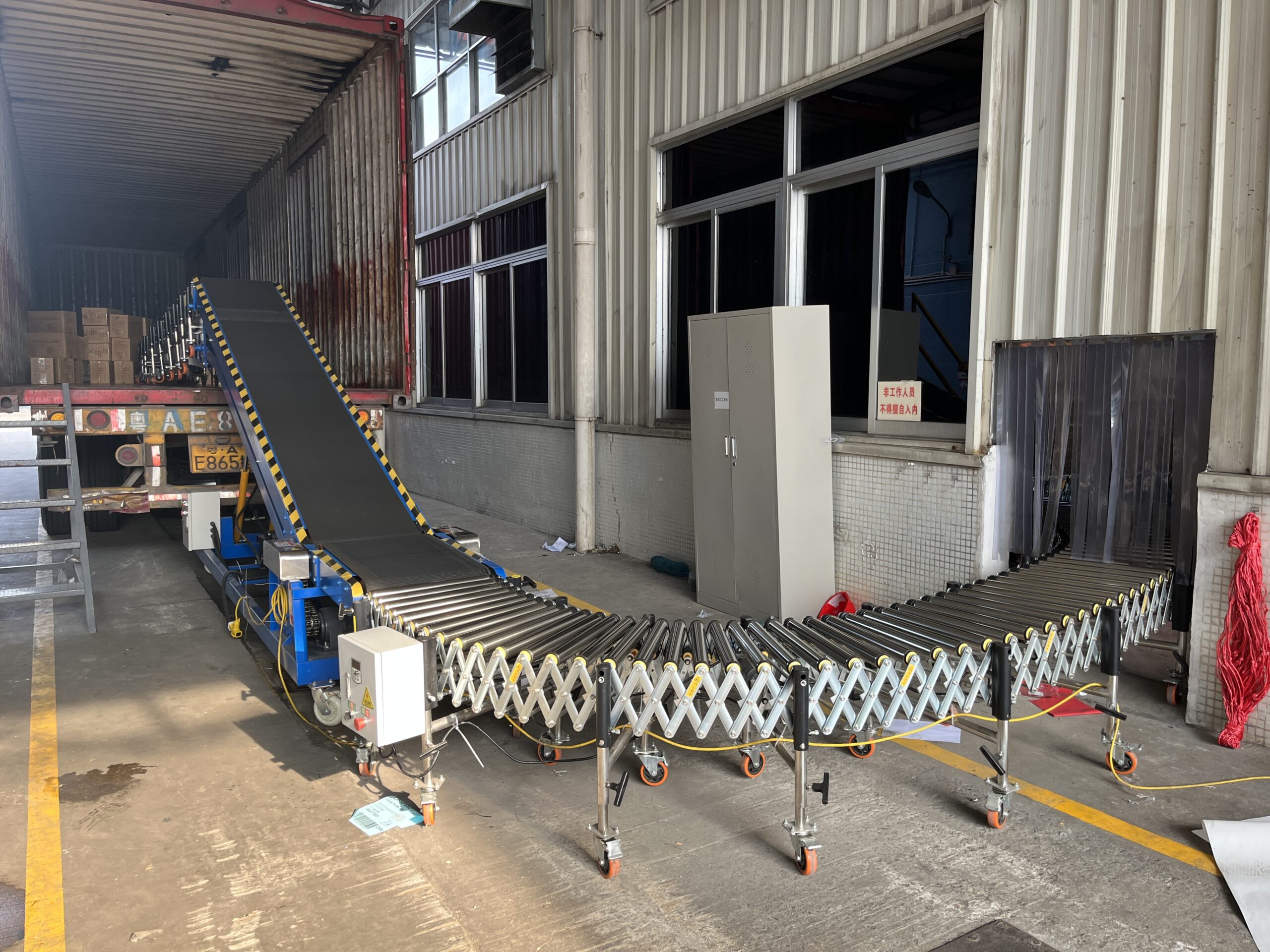

Table of Contents
Recent Posts
Optimize hardware store logistics with the right building supply conveyor systems. Our guide to tool distribution systems enhances retail warehouse automation for efficient operations.
Optimize your medical supply logistics with efficient gravity conveyor systems. Learn how to safely handle healthcare products while improving your hospital supply chain operations.
Discover how a sports equipment conveyor system can streamline your athletic gear logistics. Flexible conveyor solutions for all shapes and sizes of sporting goods.


